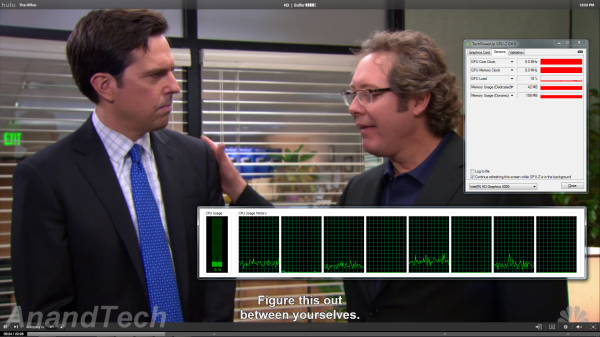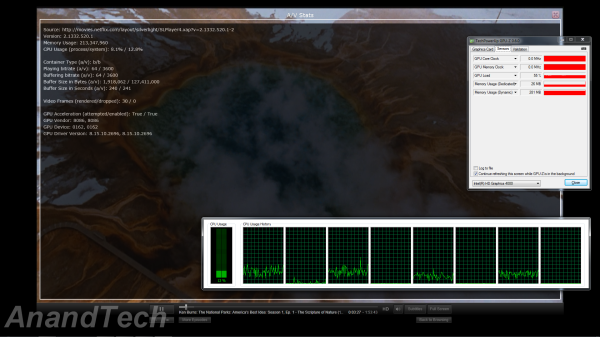Intel's Ivy Bridge: An HTPC Perspective
by Ganesh T S on April 23, 2012 12:01 PM EST- Posted in
- Home Theater
- Intel
- HTPC
- Ivy Bridge
The last time we looked at Flash acceleration in the Intel drivers, we came away disappointed. Have things changed this time around? Intel seems to have taken extra care about this aspect and even supplied us with Flash player builds confirmed and tested to have full GPU acceleration and rendering capabilities. We took the Flash plugin for a test drive using our standard YouTube clip. This time around, we also added a 720p Hulu Plus clip. In the case of YouTube, there is visual confirmation of accelerated decoding and rendering. For Hulu Plus, we need to infer it from the GPU usage in GPU-Z. Hulu Plus streaming seems to be slightly more demanding on the CPU compared to YouTube.
Netflix streaming, on the other hand, uses Microsoft's Silverlight technology. Unlike Flash, hardware acceleration for the video decode process is not controlled by the user. It is upto the server side code to attempt GPU acceleration. Thankfully, Netflix does try to take advantage of the GPU's capabilities.
This is evident from the A/V stats recorded while streaming a Netflix HD video at the maximum possible bitrate of 3.7 Mbps. The high GPU usage in GPU-Z also points to hardware acceleration being utilized.













70 Comments
View All Comments
jwilliams4200 - Monday, April 23, 2012 - link
Not really. I think HD4000 is just about right for an HTPC. Later, when the Ivy Bridge core-i3's come out, I think the i3-3225, with HD4000, will be the first choice for HTPCs.shawkie - Monday, April 23, 2012 - link
If the i7-3770T is actually ever available to buy then from a power consumption point of view it would also be a good choice (with plenty of CPU headroom for the times where GPU decoding doesn't work) . From a cost point of view it might be a bit on the high side I suppose.flashbacck - Monday, April 23, 2012 - link
As one of the few people still running a dedicated htpc, I appreciate the article.anirudhs - Tuesday, April 24, 2012 - link
You mean use your HTPC for all media, including HD-DVR and Blu-Ray? I am just getting into it now.jwcalla - Monday, April 23, 2012 - link
Getting an i7 for an HTPC is like getting a Mustang GT500 to drive Miss Daisy. Come on now, is AT a review site for Daddy Warbucks types?Ok serious question though. What's the Intel IVB driver / HW acceleration situation on Linux? I couldn't imagine dropping $100 on Windows 7 for something as simple as HTPC functionality. For nvidia we're talking $10 Geforce card + VDPAU + lowest end CPU + least amount of RAM possible + linux = HTPC solution. Or a Zotac box. Can Intel compete with that?
ExarKun333 - Monday, April 23, 2012 - link
This review is really testing the HD4000 implementation. When the dual-cores are released with the HD4000, the GPU will be exactly the same, so almost everything will be directly applicable there too.anirudhs - Tuesday, April 24, 2012 - link
If you plan on getting cable onto your PC you have no choice but Windows due to DRM issues. Some channels will not be recorded by MythTV.CoffeeGrinder - Monday, April 23, 2012 - link
With that P8H77-M config, if you use a double slot GPU in one PCIex16 slot (and so lose one PCIex1 slot) and use TV tuners in both on the remaining slots PCIex1 and PCIex16 does using the second PCIex16 slot result in the first PCIex16 running at x8 ?ganeshts - Tuesday, April 24, 2012 - link
If the second PCIe is occupied, then it will cause the first x16 to run at x8. Both these slots are electrically connected, so when you need even one lane, it takes eight away from the first PCIe slot for it.Bluestraw - Tuesday, April 24, 2012 - link
I see you didn't test madVR in Full Screen Exclusive mode - can you elaborate on the reason for this please? I read over at missingremote that FSE improved the situation significantly for madVR with the HD4000?